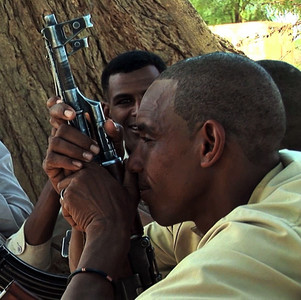Lucrative trade in Eastern Sudan
Comment:
It is not new that geopolitical issues have cast a long shadow over the Horn of Africa, contributing to the militarisation of the region. This trend was visible in eastern Sudan, for example, during the war that afflicted the area between 1994 and 2006.
Historically, geopolitical interests were the force behind arms transportation in the area. Automatic firearms were introduced during the 1960s Eritrean liberation war, when soldiers came to eastern Sudan and sold their weapons.
One source, preferring not to be identified, says that, at that time, Sudan pulled the strings behind the scenes: “Some factions from Ethiopia started to store their arms in hiding places on Sudanese soil with the knowledge of the then Sudanese government which used to provide them with logistic support.”
‘The big profits available through arms – combined with high demand – ensure the flow of arms-laden vehicles passing through eastern Sudan.’Meanwhile, it seems that the rise of Palestinian resistance groups, armed by some Islamic states, made eastern Sudan a transit zone for arms moving from Sudan’s coast to the Sinai peninsula in Egypt and then onward to the Palestinian territories.
These days, geopolitical interests are often subordinated to economic interests. The big profits available through arms – combined with high demand – ensure the flow of arms-laden vehicles passing through eastern Sudan, in particular Red Sea State.
Unsurprisingly, traffickers in eastern Sudan want to protect their lucrative trade. Mohamed, a young man with links to the traffickers, explains the extent of the earnings, saying that people made US$10,000 per vehicle carrying arms from eastern Sudan to Sinai. “Arms are usually transported in 20-vehicle convoys,” he says. “They earn huge sums.”
Major players in this trade live in big eastern cities like Kassala, Port Sudan and Suakin, often disguising their trafficking business behind phoney commercial activities, he adds.
Although economics are a major factor behind the arms trade, sources remark that it remains strategically important to some government circles. Osman Fagray, an international law expert and former head of the Red Sea State Police, says the bulk of arms enter eastern Sudan because of the Israeli siege on the Gaza strip. “The Islamist character of the Sudanese government encouraged it to facilitate arms delivery to Islamist groups,” he explains.
But who pays the price for this convergence of interests in eastern Sudan? The answer is: those working this illicit trade and, potentially, the local population. One example of the deadly nature of the arms business occurred when Israel, allegedly, carried out a series of air strikes in the region, starting in 2009 when it bombed a large convoy carrying arms to the north east of Port Sudan.
And until the rule of law clamps down on this lucrative trade, it is clear that the population is going to continue to live at the eye of the storm.
